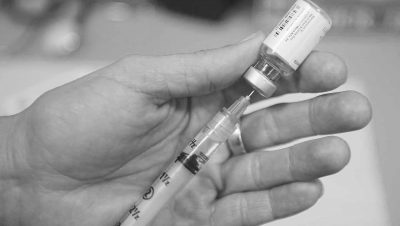Immunization with SARS [1] Coronavirus Vaccines Leads to Pulmonary Immunopathology on Challenge with the SARS Virus

This study was originally published in April 2012.
It pertains to the Severe acute respiratory syndrome, SARS-CoV (2002) which has, according to the WHO and the CDC similar features to SARS-CoV-2.
A vaccine was envisaged in relation to SARS-1. The authors document the impacts of the SARS-1 vaccine, focussing on the results of the mice and ferret lab tests.
“An early concern for application of a SARS-CoV vaccine was the experience with other coronavirus infections which induced enhanced disease and immunopathology in animals when challenged with infectious virus”.
The conclusion of the study is as follows:
“These SARS-CoV vaccines all induced antibody and protection against infection with SARS-CoV. However, challenge of mice given any of the vaccines led to occurrence of Th2-type immunopathology suggesting hypersensitivity to SARS-CoV components was induced. Caution in proceeding to application of a SARS-CoV vaccine in humans is indicated.”
This study is of relevance to the current debate and analysis pertaining to the Covid-19 vaccine (SARs-CoV-2)
***
Abstract
Background
Severe acute respiratory syndrome (SARS) emerged in China in 2002 and spread to other countries before brought under control. Because of a concern for reemergence or a deliberate release of the SARS coronavirus, vaccine development was initiated. Evaluations of an inactivated whole virus vaccine in ferrets and nonhuman primates and a virus-like-particle vaccine in mice induced protection against infection but challenged animals exhibited an immunopathologic-type lung disease.
Design
Four candidate vaccines for humans with or without alum adjuvant were evaluated in a mouse model of SARS, a VLP vaccine, the vaccine given to ferrets and NHP, another whole virus vaccine and an rDNA-produced S protein. Balb/c or C57BL/6 mice were vaccinated IM on day 0 and 28 and sacrificed for serum antibody measurements or challenged with live virus on day 56. On day 58, challenged mice were sacrificed and lungs obtained for virus and histopathology.
Results
All vaccines induced serum neutralizing antibody with increasing dosages and/or alum significantly increasing responses. Significant reductions of SARS-CoV two days after challenge was seen for all vaccines and prior live SARS-CoV. All mice exhibited histopathologic changes in lungs two days after challenge including all animals vaccinated (Balb/C and C57BL/6) or given live virus, influenza vaccine, or PBS suggesting infection occurred in all. Histopathology seen in animals given one of the SARS-CoV vaccines was uniformly a Th2-type immunopathology with prominent eosinophil infiltration, confirmed with special eosinophil stains. The pathologic changes seen in all control groups lacked the eosinophil prominence.
Conclusions
These SARS-CoV vaccines all induced antibody and protection against infection with SARS-CoV. However, challenge of mice given any of the vaccines led to occurrence of Th2-type immunopathology suggesting hypersensitivity to SARS-CoV components was induced. Caution in proceeding to application of a SARS-CoV vaccine in humans is indicated.
Introduction
Severe acute respiratory syndrome (SARS) emerged in Guangdong, People’s Republic of China, in late 2002, and spread to other countries in Asia and to Canada in the ensuing months [1]–[3]. Infection control efforts brought the infection under control by mid-2003 [4]. More than 8000 cases, including almost 800 deaths, were reported during the outbreak period [4]. Increasing age and comorbidity were risk factors for severe disease and death [5], [6], [7]. Since 2003, only sporadic cases have been reported; however, the possibility that SARS outbreaks could reemerge naturally or be deliberately released is a public health concern.
SARS is caused by a Coronavirus (SARS-CoV) [8], [9]. Limited data are available about the ecology of SARS-CoV, but bats are thought to be the animal reservoir for the virus which may be transmitted to small mammals with exposure to these small animals as the source of human infections [10]. The clinical disease is similar to other severe acute respiratory infections, including influenza; the SARS case definition includes clinical, epidemiologic, and laboratory criteria [11], [12]. A number of therapeutic efforts were employed for the disease in Asia and in Canada; however, no treatment of clear value was identified. Animal models were developed using mice, hamsters, ferrets and nonhuman primates, and efforts to identify useful treatments and effective vaccines are ongoing.
Vaccine candidates for preventing SARS have been developed by various groups and include inactivated whole virus, spike (S) protein preparations, virus-like particles (VLPs), plasmid DNA and a number of vectors containing genes for SARS-CoV proteins [13]–[28]. Phase I studies in humans have been conducted with a whole virus vaccine and a DNA vaccine [29]–[30].
An early concern for application of a SARS-CoV vaccine was the experience with other coronavirus infections which induced enhanced disease and immunopathology in animals when challenged with infectious virus [31], a concern reinforced by the report that animals given an alum adjuvanted SARS vaccine and subsequently challenged with SARS-CoV exhibited an immunopathologic lung reaction reminiscent of that described for respiratory syncytial virus (RSV) in infants and in animal models given RSV vaccine and challenged naturally (infants) or artificially (animals) with RSV [32], [33]. We and others described a similar immunopathologic reaction in mice vaccinated with a SARS-CoV vaccine and subsequently challenged with SARS-CoV [18], [20], [21], [28]. It has been proposed that the nucleocapsid protein of SARS-CoV is the antigen to which the immunopathologic reaction is directed [18], [21]. Thus, concern for proceeding to humans with candidate SARS-CoV vaccines emerged from these various observations.
The studies reported here were conducted to evaluate the safety, immunogenicity, and efficacy of different SARS-CoV vaccines in a murine model of SARS.
Read full article here.
*
Note to readers: please click the share buttons above or below. Forward this article to your email lists. Crosspost on your blog site, internet forums. etc.



